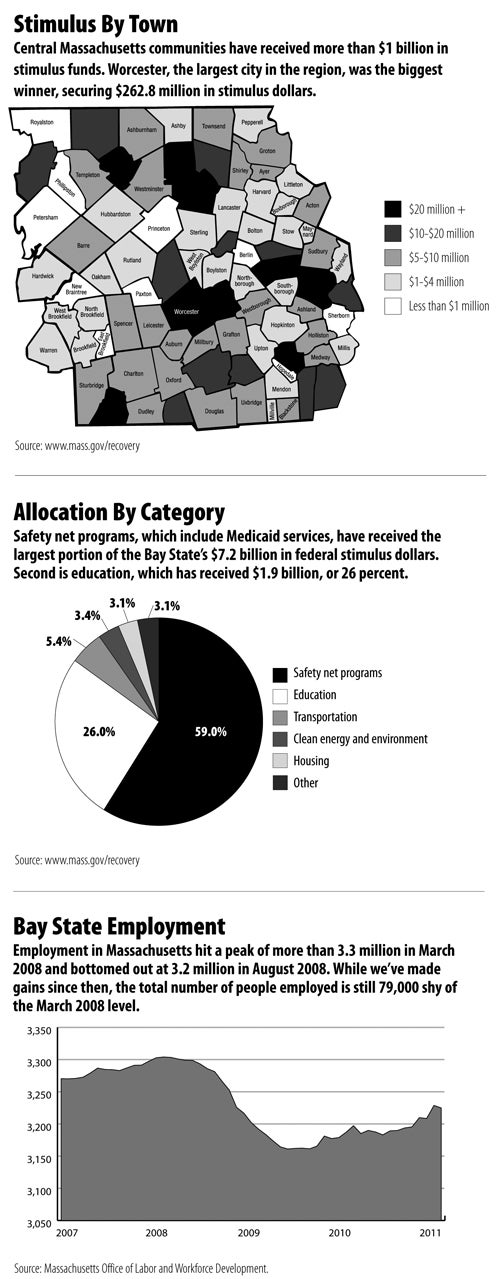Companies, institutions and local governments continue to spend federal stimulus dollars, but the majority of the money is now gone.
And for some recipients of the funds, funneled to Massachusetts and the other 49 states in 2009 to help bridge the troubled waters of recession, there could be a stimulus hangover on the horizon.
From jobs for teachers, construction workers and medical researchers to money for repaving roads, the money in Central Massachusetts and beyond is soon going to have to come from somewhere else.
Draining Coffers
Massachusetts has approximately $1.1 billion, or 16 percent, remaining of the $7.3 billion it received from Congress in 2008, according to Jeffrey Simon, director of the Massachusetts Recovery and Reinvestment Office.
Simon, who was chosen by Gov. Deval Patrick in 2009 to oversee the distribution of those funds in Massachusetts, said it’s difficult for him to know that some workers are losing jobs that were funded by the stimulus. He said his own stimulus oversight staff of 10 people will be drawn down as the end of the stimulus program approaches in 2014.
“I can’t sit here today and tell you with great certainty that all of these programs will be picked up with some other source of funding,” Simon said. “What the program was designed to do was to get people through a really tough time.”
Approximately 77,000 people in Massachusetts have received a paycheck containing stimulus funds, according to figures from Simon’s office, which are available at www.mass.gov/recovery.
The program helped retain or create 76,796 jobs, more than 7,900 of which were retained in the first quarter of this year.
Stimulus job creation numbers, which are drawn from reports funded companies file with the government, have sometimes been criticized over the past two years as overstated. A December 2010 study by the John W. McCormack Graduate School of Policy and Global Studies at the University of Massachusetts in Boston notes that some companies may have over-reported job creation numbers or may not have fully understood the reporting requirements.
Who Received Money?
The biggest recipients of stimulus in Massachusetts were safety net programs such as Medicaid assistance, which received $3.3 billion. The state’s unemployment coffers were bolstered by $706.4 million. Education was the second-biggest stimulus recipient, taking in $1.8 billion. An education stabilization fund received the bulk of that money, which helped retain nearly 4,000 full-time positions at public schools and colleges, according to the state.
Other programs included road and bridge repairs, funding for solar energy projects, workforce development staffing and money for Community Development Block Grants.
Despite a chorus of naysayers, state and federal officials as well as President Barack Obama have argued that the stimulus stopped the economic bleeding. They say that unemployment would have skyrocketed if it were not for the stimulus program.
For his part, Simon is convinced — through his interaction with dozens of stimulus recipients — that the program saved livelihoods in Massachusetts, which was one of the fastest-growing states in the country over the past two years, according to Department of Commerce.
“I feel an absolute conviction that it has made a real, strong, positive contribution to the economic vitality of Massachusetts,” Simon said. “I have to go back to asking the over 76,000 individuals in Massachusetts who received a paycheck from the stimulus in the past two years, was it worth it? I think you would hear a pretty resounding ‘yes’ that it was worth it.”
The Massachusetts economy grew 4.2 percent in 2010, which made it the fourth-fastest growing state in the nation, according to a recent report from the Department of Commerce.
Unemployment in Massachusetts has been declining since November 2009, where it hit a seasonally adjusted peak of 8.8 percent. The rate for May was 7.6 percent.
The rate had been climbing for two years from an early 2008 trough of 4.4 percent. The Massachusetts unemployment rate remains below the national average of 9.1 percent. The national trend was similar to that observed in the Bay State. Unemployment peaked in late 2009, around the start of the stimulus program, and has fallen approximately one percentage point since.
Transparency
The state and federal government created extensive Internet databases to show the public how the money was being spent. Simon said that two of his staffers were formerly employed by the attorney general’s office and had worked on cases involving cost recovery and the tunnel collapse in the infamous Big Dig project in Boston.
“The symbolism of that is that we wanted to make a statement very early on that we were very serious about fraud waste and abuse,” Simon said.
While much of the money is spent, Simon points out that more than $1 billion remains. The largest program that will be funded with the remaining money is the Race to the Top program in public schools, which is slated to run through 2014.
Race to the Top awards money to schools each year who meet certain benchmarks on teacher performance and school quality. Nine states, including Massachusetts, were awarded funding last year under the program.
A slew of the 198 stimulus-funded programs that remain in existence this month have varying degrees of funding left to spend. They include support for schools, construction projects and housing assistance.
Asked if he would have done anything differently with the stimulus program if given another chance, Simon said that he would have liked more vertical construction projects as opposed to paving and bridge projects, because they would have created work for a wider swath of construction professionals. Simon also said he regretted that the state was unable to spend stimulus funds on municipal building projects.

